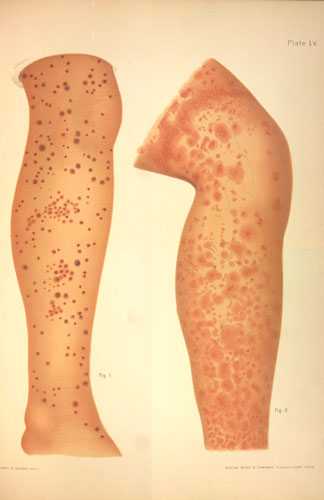We’ve launched a new web portal! Visit findhistory.nd.gov to search our collections.
Due to a road closure, the Killdeer Mountain Battlefield State Historic Site is temporarily closed.
Intro | Frontier Scout | Wales | Trobriand | Surgeon Reports | Marsh | Indian Gardens

Scurvy, or scorbutus, occurs in humans who lack Vitamin C in their diet. Vitamin C, which humans cannot produce in their own bodies, must be consumed in adequate quantities to maintain the strength of collagen and blood vessels. Scurvy results in bleeding of the tissues which can be seen in the hair follicles of the leg and in the gums and other mucosal surfaces. As the disease advances, the patient becomes unable to walk, the teeth fall out, and wounds open on the skin.
The disease was commonly associated with sailors who were at sea for many months with few vegetables or fruits to provide the necessary Vitamin C. When the British Navy learned that sending ships to sea with lemons and limes decreased the incidence of scurvy, British sailors came to be called “limeys.”
The cause of scurvy – which Army surgeons called the “scorbutic taint”- was well-known by 1864, but the Army had not solved the logistical problem of supplying soldiers with vegetables and fruits at remote posts. River traffic ceased by early November and railroads did not move across northern Dakota Territory until the mid-1870s. Grasshoppers regularly destroyed summer gardens, and few posts had storehouses that did not freeze. The use of canned foods was relatively new, but cans of food were heavy and difficult to transport. By 1870, most of the posts had been modernized with better storage facilities, and research by Army physicians (known as surgeons) resulted in greater knowledge of dietary prevention of scurvy. Army surgeons ordered the regular serving of pickles and vinegar as the first line of defense against scurvy, but eventually canned and fresh fruits and vegetables found their way into the enlisted men’s diet.
Address:
612 East Boulevard Ave.
Bismarck, North Dakota 58505
Get Directions
Hours:
State Museum and Store: 8 a.m. - 5 p.m. M-F; Sat. & Sun. 10 a.m. - 5 p.m.
We are closed New Year's Day, Easter, Thanksgiving Day, and Christmas Day. We are closed at noon Christmas Eve if it falls on Mon.-Thurs. and are closed all day if it falls on Fri.-Sun.
State Archives: 8 a.m. - 4:30 p.m. M-F, except state holidays; 2nd Sat. of each month, 10 a.m. - 4:30 p.m. Appointments are recommended. To schedule an appointment, please contact us at 701.328.2091 or archives@nd.gov.
State Historical Society offices: 8 a.m. - 5 p.m. M-F, except state holidays.
Contact Us:
phone: 701.328.2666
email: history@nd.gov
Social Media:
See all social media accounts